MP3.com Lives On, Part 2
- Posted by mariteaux on February 23rd, 2022 filed in Sperging
- Comments Off on MP3.com Lives On, Part 2
And so, we conclude the two-part MP3.com CD-ROM saga, and cover MP3.com for the final time on the Scratchpad. It’s definitely a little bittersweet watching these last few posts trickle out. I had the strange realization the other day that I have zero clue where I’ll talk about random albums, should I ever get the urge. Possibly the group blog. It’s worth it, and the Scratchpad will never be totally gone anyway–but yeah, my fuzziness for a time before it outweighs all, and that’s where I’m trying to get back to in my life.
As far as MP3.com goes? That’ll always live on in our hearts–largely because it tanked before I was old enough to have memories. Still, I am eager to listen to more sample tracks from these kinds of discs (I found out the Diamond Rio PMP300 MP3 sampler CD-ROM is on the Internet Archive, baller), and I’ll probably do a second comb through of these discs after I’m done with the blog stuff.
This is really more of a small sampler of goodies than anything else. Let’s get to it!
Disc two: Life Out of Bounds
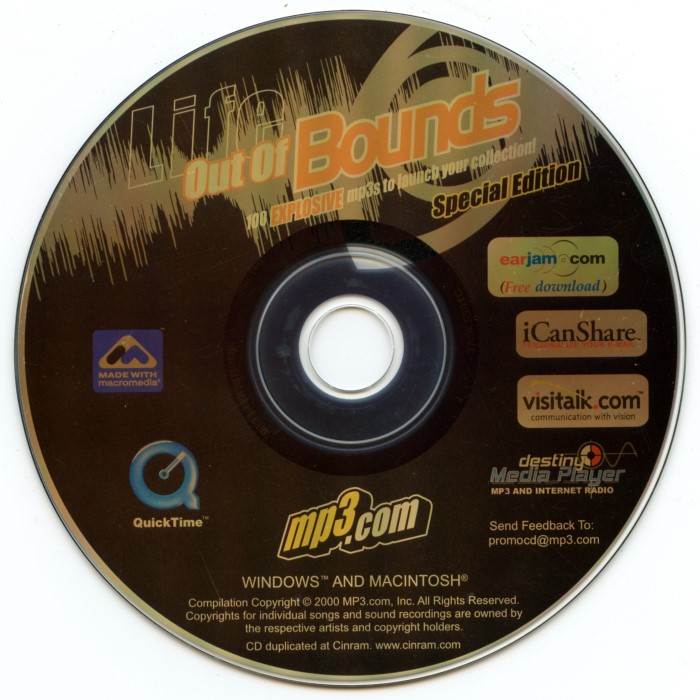
Life Out of Bounds is the second of the discs, and the one I had to burn to a CD-R to get working. Aside from the installation hassle, this was also the more daunting one to dig through. 100 MP3s to listen to? That’s a lot of music. This one’s marked as a “special edition” on the CD, but I couldn’t tell you what was so special about it, nor what this was released for. It’s the later of the two discs, though; the MaTT disc came out in 1999, and this one is marked 2000.
All the window dressing
Well, MP3.com wasn’t quite done shilling Pixelon yet when this came out, but once again, the videos are just generic MPEG-1 files and Windows Media Player (third-party codec pack I installed a while ago notwithstanding) took them just fine. Apparently, friendship ended with Firetalk, because this one instead shills an identical-looking program called visitalk.com. Isn’t it wild how using your computer to make voice and video calls was such a revolutionary thing 20 years ago?

This one also includes an advertisement for the infamous My.MP3.com service that got the labels in a tizzy way back when. Beam-it, the software to scan your CD collection with, is included on the disc, though obviously I didn’t bother to install it as MP3.com doesn’t exist anymore.

A lot of the advertisements this time around are for in-house services, actually. There’s “edrenaline”, which was a section of the site designed to appeal to skaters, surfers, snowboarders, and the music and media popular in those communities (in the late 90s). There’s seeUthere.com, which apparently automated the process of organizing in-person community events through ticket sales, invitations, and providing directions (how quaint). Finally, there’s Music Greetings, which lets you send e-cards with MP3.com songs attached–wait, e-cards?
How’s the music?
LOoB separates its artists into five occasionally fast-and-loose genres: Alternative, Electronic, Hip Hop/Rap, Metal, and Pop & Rock. Compared to the MaTT disc, which was nearly entirely rock and punk artists, Life Out of Bounds has a wider variety of music, including plenty of ambient, trance, techno, and house artists and a whole lot of underground rap to boot.
I’m not terribly keen on the way things are sorted on this disc though. Pop & Rock really should be called Singer-Songwriters, except there’s plenty of those in the Alternative category as well. One artist in the Metal section had a straight up ambient tune with no guitars, yet was sorted in Metal and not Electronic. The Alternative section had bands with basically nothing alternative about them; the first band in the category, Agent 51, cites AC/DC as a fuckin’ influence.
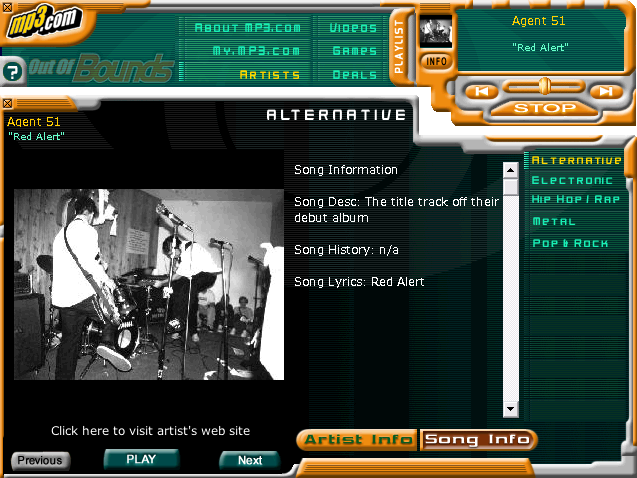
Even more schizophrenic is how you’ll get artist info and song info with only some of the songs. A lot of tracks straight up don’t have any song information. Most don’t have lyrics, a bunch don’t have song history, and song descriptions range from very clearly written from a “please sign my band” kind of voice, to being written by a single dweeb who’s just out on a lark:

Artist bios fall similarly. Some are very clearly done by a professional bio writer and were likely part of that artist’s press kit, some are more band histories as written by the wistfully-nostalgic bassist, and some are just someone going “Hi, I’m 16 and I make music to express myself”.
It’s not so much that I don’t expect such a wide cross section of artist intents, but that MP3.com was so non-discriminatory about including all of them. For a pressed, silver-bottom CD-ROM, you would expect their team to only pick the most serious artists of the lot, ones with full bios and lyrics handy, and yet that very much wasn’t the case. Even the band images range from professionally taken and touched up portraits to someone’s mom taking a photo of the band huddled around a streetlamp.
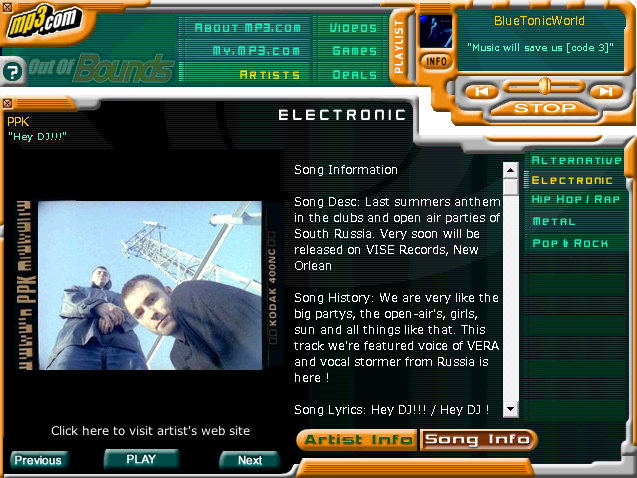
So what drove the inclusions here? I’m guessing chart success. MP3.com actually featured its own Billboard/Cash Box-like charts that updated weekly with what was trending on the site. If you recall our old friends PPK, they’re on this disc with “Hey DJ!!!”, which they had edited their artist profile picture at one point to mention had topped the Hard House charts for six months straight. Another song on here, The Cynic Project’s “Matrix ][“, mentions in its song history that it was #1 on the site’s Dance chart for two weeks.
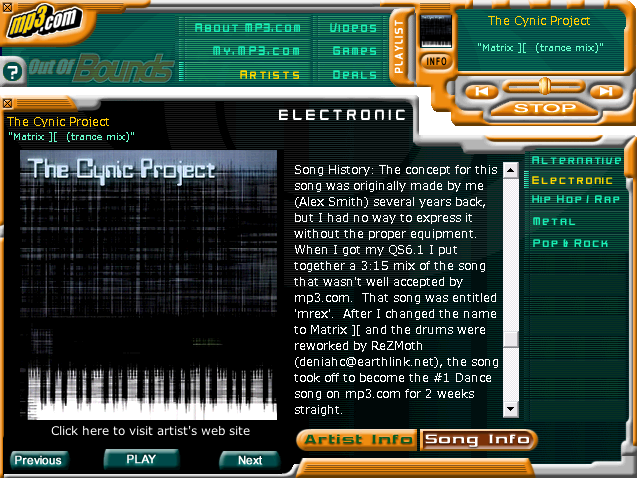
I doubt it’s much different for the MaTT disc, but this means that LOoB is the definitive look at a real specific point and time for MP3.com. This isn’t random artists, this is what was taking off there! And sure, anyone could’ve guessed that, but it’s nice to have confirmation, and it’s nice to see that this is well and truly a historical piece, chosen by the people, for the people.
That said, I do wonder if there were any ulterior motives in the curation process. A surprising amount of these artists on both discs are actually Christian artists. For some, like Fono on the MaTT disc, I only found out when I looked them up. Others, like The Funky Preacha and his song “2pray”, are a bit less ambiguous. Whether this is just because MP3.com was so all-inclusive or it was a deliberate stab at trying to make MP3.com more inviting to a country that was still rather religious in the 90s and 2000s depends on if the chicken comes before the egg.
Anyway, some highlights. (I found nearly all the guitar rock on here to be pretty underwhelming, so my focus is with the other genres.)
Fat Beat Squad – “Money”
Well, this one was a definite outlier in the Alternative section! Wah-wah guitars, prominent bass, horns–what a crazy funky brew going on. It takes a bit for the vocals to come in, but they’re pretty catchy too.
Fat Beat Squad were based out of San Diego at least into the mid-2000s. Unfortunately, while they had an album out called Delicious, even Discogs doesn’t have it in its database. The only other song of theirs I can find is “Sunny Sunny Day”, which was featured as part of the Independent Underground Music Archive, where lots of MP3.com artists crossed over back in the day.
Not Applicable – “Threshold”
Whoa. This little ambient tune in the Electronic section sounds fucking cool. It’s entirely beatless, just this eerie drone of sound and the vocal snippet (as I learned, not sampled!). It’s seven minutes long, but man, it’s a vibe.
Not Applicable is one of those bedroom artists I was referring to earlier in the posts. I know nothing about this girl, but she describes herself as “me myself and I, a synth a microphone and some kickass audio software. No history really, just me farting around.” This track was based on the first thing she ever learned to play on piano, the “Moonlight Sonta”.
The Cynic Project – “Matrix ][“
Some more typical trance stuff here, but y’know what, it sounds like some PS1 games I’ve played and I like it. For a look into the Cynic Project’s workflow, the “QS6.1” referred to in the song bio is the Alesis (same folks as made the ADAT, yep) QS6.1 Voice Expandable Synthesizer, freshly introduced in 1999, and expandable with PCMCIA cards!
This one was apparently a lot more noteworthy than is apparent just from the CD. This guy, one Alex Smith, was apparently MP3.com’s top earner at one point–and “Matrix ][” achieved six million downloads in total. (See my confusion at how no one remembers MP3.com today?) He’s still active, as of my writing this! You can check out more of his music at cynicmusic.com.
Tonedeff – “Monotony”
Here’s one from the Rap section. I found a lot of it fairly underwhelming, either recorded badly or boring lyrically, but this guy’s got a great voice and his bars are pretty complex. Highly slick flow. I dig it.
Tonedeff also seems pretty noteworthy, from what I’ve read. Dude’s opened for Brand Nubian, Royce da 5’9″, Common, even KRS-One. Reading the Wikipedia article aside, he’s still active and you can still buy the Monotone EP through his Bandcamp–and those sales numbers don’t lie. Someone’s listening to Tonedeff. I can’t argue.
Rye – “Silly Games”
One more! Let’s take this back into rock territory. This kinda reminds me of some of Incubus’ more ballad-y songs, which would make sense for the time. You can hear it in his voice especially.
Rye is one Rye Randa, who did the pretty typical songwriter thing of turning his songwriting chops into TV show and film licensing chops. It’s a little hard to connect the two, but some of the wording (like “as a natural progression, he began to produce his own material”) and details (like returning to LA after college) are featured in both his MP3.com bio and his IMDB bio. Plus the photos look similar. Anyway, He’s one half of The Ontic now, still finding work to this day, and he even wrote a song for Three Dog Night at one point. What a bizarre crossover.
As an amusing end note, like how Kill Hannah featured on MaTT, the Pop & Rock section features none other than a little band called Hoobustank, who would soon change their name to Hoobastank. That Hoobastank. In general, I think it’s pretty neat how I already recognized a few of these artists going in. PPK, of course, we knew from my original MP3.com posts, but also encomiast, whose self-titled EP I used to demonstrate what the early DAM discs looked like, has a song called “azazel” on here.
It all makes sense–if I can find it still now, it was probably at least a little successful then.
How about those videos?
There’s only three videos on here, two of which are movie trailers and one of which is a game trailer for the recent Die Hard Trilogy 2 for PlayStation and Windows.
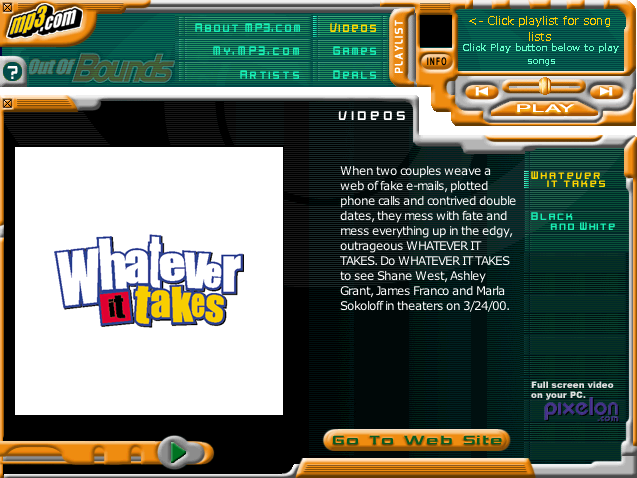
The movie trailers in particular do a pretty good job of demonstrating who this disc was aimed at. Whatever it Takes is a garbage looking teen romance comedy about two conventionally attractive dweebs trying to get two girls by being dickheads. Unsurprisingly, the movie has a 16% on Rotten Tomatoes.
Black and White is a little more interesting. It’s from 1999. It’s actually pretty closely associated with the Wu-Tang Clan, and I think the entire group appears in the movie. Their executive producer appears as a rich rap mogul, and the gist of the kinda-confusing plot is that this cop is looking to infiltrate his sphere by offering $50,000 to one of his buddies who’s really good at basketball. When the rap mogul realizes what he might say to this random cop, he tries to have his buddy bumped off, and he gets this hipster white kid who wants in on this really cool scene of black dudes with rich lifestyles to do it. And evidently, he does it!
Oh, and Mike Tyson is in it. As himself. “On parole”, as he says in the trailer. I couldn’t be assed to rip anything from this disc, but this trailer, or something fairly close to it, is on YouTube. It’s also apparently not very good, and the plot sounds like an absolute mess. The comments on the upload seem to bear out just how mediocre it was.
About the only other thing lumped in with the trailers actually isn’t a trailer at all, but rather a…tutorial for MP3.com in game form featuring Impy, the MP3.com Electronic Community Imp. Yeah, so this random gigantic pig sleeping bag character apparently teaches you how to use the artist calendar and suchlike through an interactive MP3.com adventure. It sounds utterly bizarre, but with the site long gone and as little information out there as there is, I unsurprisingly could dig up nothing on Impy. What a fascinating idea though.
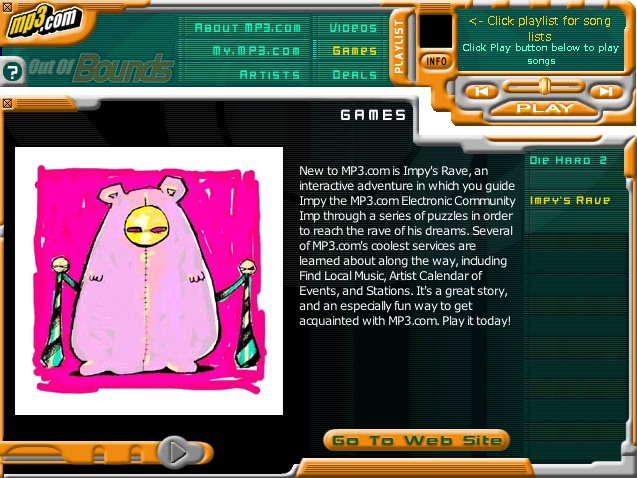
Statistics for audio nerds only
MusicMatch tag found: 8204 bytes long, metadata section is 7868 bytes long (offset 0x0029EEB1).
Software ver 3.00, tag ver 3.00, Xing encoder ver 1.01, no header.
One of the biggest reasons I wanted some of the original MP3.com MP3s on hand was to be able to solve the final technical mystery of the entire saga, which was signal flow. What encoders were the bands using? How did MP3.com enforce a 128kbps max bitrate? Was it through any additional transcoding (which would be apparent if all MP3s used the same encoder), or did they scan each MP3 for encoding profile?
I got out my trusty mp3guessenc and went to work on every single MP3 across both discs. Here’s what I found:
- Xing was by far the most popular encoder; 91 of the 125 MP3s across both discs were encoded with some flavor of Xing. These bunch up mostly in the rock and pop sphere; encoder choice varies more for the more fringe genres (electronica, metal, and rap).
- For what wasn’t Xing, most of the remaining (22) were Fraunhofer encodes, often ACM encodes, so straight out of someone’s workstation, most likely. BladeEnc made up the smallest chunk of MP3s. 12 of the 125 were from Blade.
- There were no Lame encodes, by the way.
- MusicMatch was an incredibly popular way to encode MP3s. mp3guessenc found a MusicMatch tag in a number of the Xing-encoded MP3s, as seen above. Indeed, Xing was the encoder of choice for MusicMatch Jukebox. Seems like a lot of folks, either on MP3.com’s recommendation or because their PCs came with it, used that to encode the MP3s that they’d upload to the site.
- All in all, this is proof that normal, well-adjusted people just use the most convenient option.
The strangest MP3 on the entire disc has to be “Takin Over 99” from an artist called NAAM. Not only was there zero in the way of artist bio or even photos, but the MP3 is encoded at 160kbps, the only one out of the entire batch of 125 to not be 128kbps. There is an MP3.com artist page in the MP3 tags (mp3.com/music/Rap/1224.html, if someone wants to try digging through the tarball), but I don’t believe this came from the site itself. It’s just too big an outlier to fit.
The rest of them were very clearly site-sourced, 128kbps CBR, likely direct from the download option. Some sounded better than others, as to be expected, but none were absolutely offensive or horrific to listen to. As such, I’ve uploaded all the MP3s from both discs to archives for your perusal, if you’re brave enough.
My final word is that I think MP3.com had something on the backend that scanned the encoding profile (bitrate, encoding mode) of each MP3 uploaded, rejecting the ones that didn’t match. Internally, their system then generated a 24kbps lo-fi streaming copy for modem users.
You can read my full, painfully detailed notes as to what was what in the tests if you’d like. I’m about ready to wrap up.
The business versus the thoughtform
Ah, MP3.com. For a site I never got to visit while it was still extant, I’ve sure spent a shitton of time on you. What really do I say to sum up what I haven’t already said in now six different blog posts? I’ll give it a shot anyway.
This disc was pretty spotty. I’d say maybe a 25-30% success rate as far as me liking the songs. That said, the good ones always outweigh the shitty ones, and I’m really happy to see that the vast majority of the artists on the site that I’ve looked into, both this year and in 2020, still have presences elsewhere. When I wrote my initial MP3.com posts, I didn’t think any of the music survived–but of course, that’s far from the case.
In some cases, these artists are still selling their MP3.com-era material, and where they’re not, if the album was through a proper label and not through DAM (and even then, sometimes through DAM), you can still likely get it secondhand through eBay or Discogs. There’s no denying that MP3.com disappearing was a loss, but if you know what you’re looking for, you can find at least some of it still.
And really, that’s the part that hurt the most. The loss of the music. I’ve railed a lot over the years over people’s tendency to boil retro nostalgic revivalism down to the surface level. I still think it’s goofy, and I still think in extreme cases, it’s actually kind of offensive. The 80’s were a little bit more than neon, Culture Club, Blade Runner, and Nintendo, lads.
Yet, these days, I feel it doesn’t particularly matter. None of us were there. The people that were there all have massively different opinions these days on what was there. Everything about any wistful search of the past is horrifically biased.
Looking at MP3.com itself, it’s all page grabs, screenshots, old news articles, and conjecture. MP3.com was a business that did business things and set out to try its hand at revolutionizing music distribution through the internet. It had a lot of forward-thinking ideas, and yet, it bothered its users plenty like any gigantic site does:
With MP3’s acquisition of SeeUThere.com, a one-stop site for event planning, the company is arming its roster of aspiring artists with the tools of self-promotion. This is not to say that the relationship between MP3.com and its registered talent has always been smooth. Some argue that the company can do more to market the artists who are giving away their music — after all, MP3.com is profiting from ads it places on those pages.
MP3.com has responded. It has taken some of its more popular acts, like MP3 cover girl Emily Richards, on the road. While that still did not sit well with smaller artists — and those who have not made it onto MP3 compilations or featured slots on its site — MP3 finally delivered the compensation many have been asking for.
Meanwhile, the music and our enjoyment of it? Those are still affecting us to this day. The thoughtform of MP3.com in our minds, as inaccurate as it may be, matters infinitely more than what MP3.com actually was. We’re alive right now. Our interest in the past makes us happy in the present, where it matters. Whatever direction it pulls you in, whatever makes you fuzziest to imagine, is what MP3.com was.
It’s all up to you. If you want MP3.com to be an exciting, fascinating example of what being ahead of your time looks like, it’s that. If you want to flatten MP3.com along with the rest of the dot-coms, a cautionary tale for plenty of sites these days without a concrete business model, it was that. If MP3.com was a landfill of cheap bedroom DJs and garbage bar bands, hey, how can I say no? Point is, the thoughtform lives on through us.
Thanks for reading.
